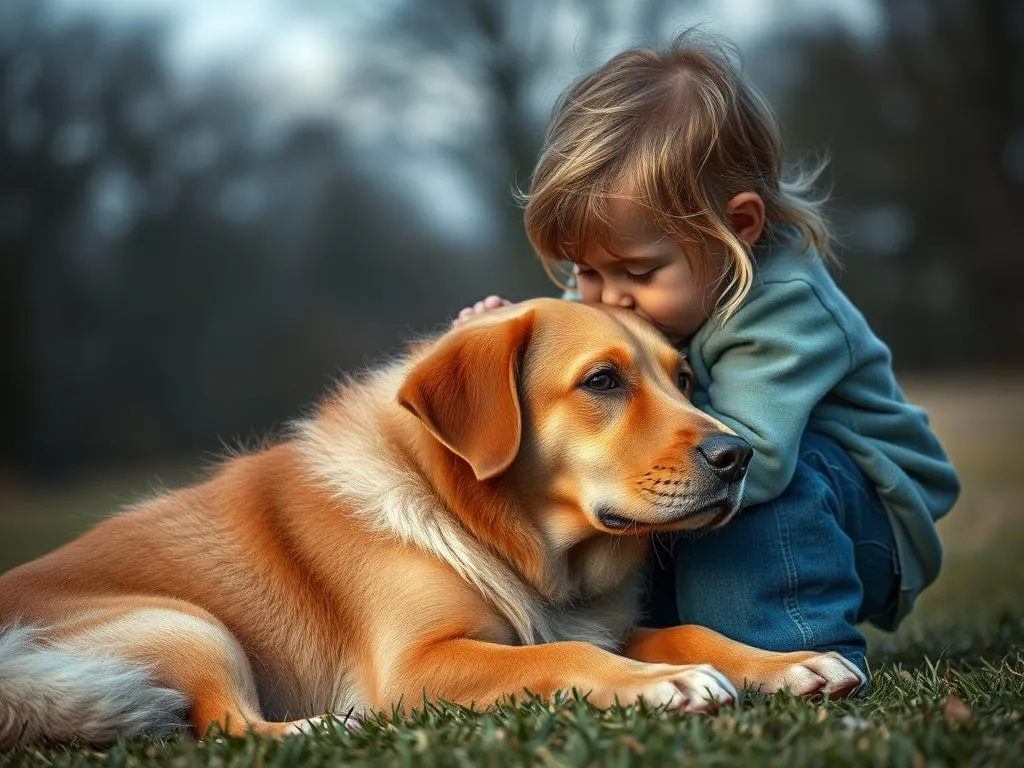
The bond between children and their pets is profound and often filled with joy, companionship, and unconditional love. When a beloved dog passes away, it can leave a significant emotional void, especially for young hearts that have experienced such a deep connection. It’s crucial to address the grief that children feel during this challenging time, as it can influence their emotional well-being and development. This article offers guidance for parents on how to support their children through the complex experience of losing a pet.
Understanding Grief in Children
The Nature of Grief
Grief is a natural response to loss, manifesting in various ways as children try to process their feelings. While adults may express grief through tears, anger, or withdrawal, children often exhibit their feelings differently. They may alternate between sadness and playfulness, not fully understanding the permanence of death. Helping children cope with the death of a dog requires recognizing these unique expressions of grief and providing comfort and support in a manner that makes sense to them.
Age-Related Understanding of Death
Children’s understanding of death evolves as they grow. Their perception is influenced by developmental stages:
-
Toddlers (ages 2-4): At this age, children may not grasp the concept of death. They might sense the absence of their pet but won’t understand its permanence.
-
Preschoolers (ages 4-6): Children begin to understand that death is final but may believe it can be reversed. They may ask questions like, “When will my dog come back?”
-
School-age children (ages 6-12): By this stage, children start to comprehend that death is irreversible. They may experience feelings of guilt, thinking they could have done something to prevent the loss.
-
Teenagers (ages 13+): Teens understand death more fully and can experience complex emotions, including anger and depression. They may seek more independence in their grieving process.
Recognizing where your child falls within these developmental stages is essential for helping children cope with the death of a dog effectively.
Preparing for the Loss
Anticipating the Death of a Pet
If your dog is aging or suffering from an illness, it’s vital to prepare your children for the impending loss. Recognizing the signs of pet illness can help parents initiate conversations about the situation. Discussing what’s happening with your pet can provide children with a clearer understanding of the reality of death, helping to ease the shock when it occurs.
Open Communication
Encouraging open communication is key in this process. Allow your child to express their feelings, fears, and questions about death. Use age-appropriate language to discuss the situation honestly. For example, you might say, “Our dog is very sick, and we need to prepare for the possibility that he might not be with us much longer.” This dialogue fosters trust and reassures your child that it’s okay to talk about their feelings regarding the loss.
Supporting Children During the Loss
Creating a Safe Space for Grief
When a dog passes away, creating a safe space for grief is crucial. Allow your children to feel and express their emotions freely. Encourage them to share their thoughts and feelings, whether they’re sad, angry, or confused. You might say, “It’s okay to feel sad. I feel sad too.” This validation helps children understand that their feelings are normal and that they are not alone in their grief.
Memorializing the Pet
Memorializing your dog can be a meaningful way for children to cope with their loss. Consider organizing a small memorial service where family members can share fond memories. Creative activities, such as making a scrapbook filled with photos and notes about your pet or planting a tree in their memory, can provide a lasting tribute that helps children process their grief.
Answering Questions
Children are naturally curious and may have many questions about death. Be prepared for questions like, “Why did my dog die?” or “What happens to him now?” While it’s important to provide honest answers, it’s equally essential to reassure them that feelings of sadness and confusion are normal. A simple explanation like, “Sometimes, our pets get very old or sick, and their bodies stop working,” can help children understand the situation more clearly.
Coping Strategies for Children
Encouraging Expression
Encouraging children to express their grief through various channels can be highly beneficial. Activities like drawing pictures of their dog, writing letters to their pet, or simply talking about their feelings can serve as therapeutic outlets. Creative expression helps children process their emotions and can provide a sense of relief during a difficult time.
Engaging in Activities
Maintaining routine and engaging in activities can help distract children from their grief and provide comfort. Suggest activities that your child enjoys, such as going for walks, playing with friends, or engaging in hobbies. Keeping a consistent routine can also provide stability, helping children feel more secure in the aftermath of loss.
Professional Help
Sometimes, children may struggle to cope with their grief and may benefit from professional support. Signs that a child may need help include prolonged sadness, withdrawal from friends and family, changes in behavior, or difficulties in school. If you notice these signs, consider reaching out to a child counselor or support group specializing in pet loss. These professionals can provide the tools and support needed for children to navigate their emotions in a healthy way.
Moving Forward After the Loss
Understanding the Healing Process
The healing process after losing a pet is unique for every child. It’s essential to normalize the timeline of grief; some children may bounce back quickly, while others may take longer to heal. Patience and ongoing support from parents are crucial during this time. Remind your child that it’s okay to miss their dog and that feelings of sadness may come and go.
Introducing New Pets
As time passes and healing occurs, you may consider introducing a new pet into your family. The decision to get another dog should be a family discussion, allowing your child to express their feelings about it. It’s essential to ensure that your child is ready and that the new pet is embraced as a welcome addition rather than a replacement for the lost pet.
Conclusion
Navigating the loss of a beloved dog is challenging for both children and parents. By understanding the nature of grief and providing the necessary support, parents can help their children process their emotions and heal from the loss. Remember that grief is a personal journey, and each child will cope in their own way. Remaining attentive and supportive throughout this process can help children find comfort in their memories and gradually move forward.
While the experience of losing a pet is undoubtedly painful, it can also provide an opportunity for valuable lessons about love, loss, and the importance of expressing feelings. With patience, open communication, and a supportive environment, parents can guide their children through this challenging time, helping them emerge stronger and more resilient.









